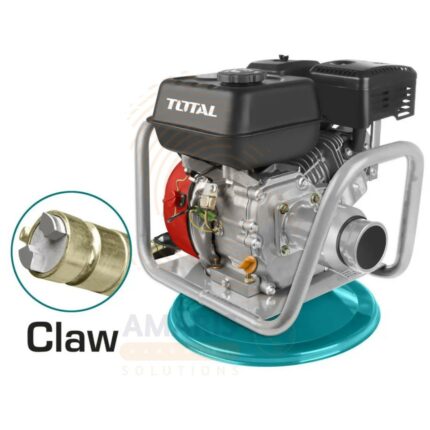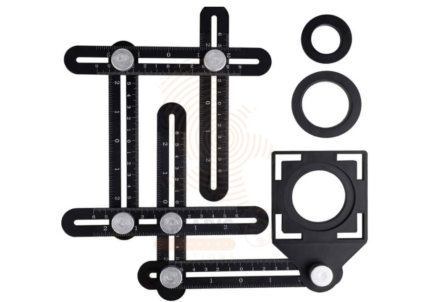Concrete Mixer
PRODUCT DESCRIPTION
A concrete mixer is a vital construction machine designed for perfectly blending cement, aggregates (such as sand and gravel), and water into high-quality concrete. It features a rotating drum on a sturdy frame—either powered by electricity, gas, or manually—that keeps the mixture in a homogenous, workable state to ensure consistency with each batch. Concrete mixers mitigate manual labor, speed up work, and guarantee a uniform concrete mix suitable for foundations, slabs, pillars, beams, driveways, and more. Variants include portable barrel mixers for small projects and large-capacity tilt or drum mixers for commercial use, ensuring proper mixing, reducing waste, and improving overall construction efficiency.
Uses
- Mixing Concrete for Construction
- Creates uniform mortar for pouring foundations, sidewalks, driveways, and structural components.
- Preparing Mortar and Grout
- Mixes dry materials with water to form porous or grout for tiling and masonry.
- Landscaping and Outdoor Projects
- Produces concrete for constructing paths, flowerbeds, hardscaping, and garden features.
- Repair Work
- Facilitates quick on-site mixing for pothole repairs, patching damaged slabs, and fixing curbs.
- Batch Mixing for Small Jobs
- Offers efficient small-batch mixing to minimize concrete waste and maintain freshness.
- Industrial and Commercial Building
- Powers medium- to large-scale construction sites with consistent concrete supply for beams, pillars, and infrastructure.
- DIY and Residential Applications
- Ideal for mixing small quantities of concrete for home improvement, setting posts, or building patios.
- Creative and Artistic Projects
- Used for crafting decorative elements like planters or sculptures with custom mixes.
- Agricultural Uses
Mixes batches for constructing fencing posts, foundations of outbuildings, or laying concrete floors in barns.
Safety Precautions
- Wear Protective Gear
- Use safety goggles or glasses to guard against splashes of cement or aggregate.
- Wear gloves to protect hands from abrasive or caustic concrete and to improve grip.
- Use a dust mask when loading dry mix to prevent respirable silica exposure.
- Wear hearing protection around loud, engine-powered mixers.
- Inspect Equipment Before Use
- Check the drum, frame, and mixing blades for cracks or wear.
- Verify that the power cord or fuel lines are intact, and wheels or supports are stable.
- Stabilize the Mixer
- Position the mixer on level ground to prevent tipping.
- Secure wheels or use stands if available.
- Mixing Safety
- Load components in correct order—typically water first, then aggregate and cement—to reduce splash.
- Avoid overloading beyond capacity to prevent motor strain or instability.
- Never insert hands or tools into the drum while it is rotating.
- Electrical and Fuel Safety
- For electric mixers: use properly grounded outlets and inspection for damage; keep electrical connections dry.
- For fuel mixers: fuel only when cooled; store fuel in approved containers and avoid spills or ignition sources.
- Cleaning and Maintenance
- Clean the drum after use before concrete hardens; use water and a brush or designated cleaning tool.
- Turn off and unplug or shut down the mixer before cleaning.
- Work Area Safety
- Keep area around the mixer clear of clutter and walkways unobstructed.
- Use caution when maneuvering wet, slippery mixer trailers.
- Emergency Preparedness
- Know how to shut the mixer off quickly.
- Keep a fire extinguisher or first-aid kit nearby if working with fuel or in remote locations.
- Training and Operation
- Only trained individuals should operate the mixer.
- Review manufacturer instructions thoroughly before use.


 Acrylic Sealants
Acrylic Sealants Construction Adhesives
Construction Adhesives Double-Sided Tape
Double-Sided Tape Duct Tape
Duct Tape Electrical Tape
Electrical Tape Epoxy & Resins
Epoxy & Resins Masking Tape
Masking Tape
 Automotive Wrenches & Socket Sets
Automotive Wrenches & Socket Sets Battery Chargers & Jump Starters
Battery Chargers & Jump Starters Car Jacks & Stands
Car Jacks & Stands Car Wash & Detailing Products
Car Wash & Detailing Products Diagnostic Tools
Diagnostic Tools Tire Inflators
Tire Inflators Vehicle Lighting
Vehicle Lighting Oil & Lubricants
Oil & Lubricants
 Adhesives & Sealants
Adhesives & Sealants Bricks & Blocks
Bricks & Blocks Cement & Concrete
Cement & Concrete Drywall & Plaster
Drywall & Plaster Flooring (Tiles, Wood, Laminate)
Flooring (Tiles, Wood, Laminate) Lumber & Plywood
Lumber & Plywood Paints, Primers & Coatings
Paints, Primers & Coatings Insulation Materials
Insulation Materials Roofing Materials
Roofing Materials
 Circuit Breakers
Circuit Breakers Electrical Cables & Wires
Electrical Cables & Wires Switches & Sockets
Switches & Sockets Fuses & Relays
Fuses & Relays Connectors & Terminals
Connectors & Terminals Electrical Boxes & Panels
Electrical Boxes & Panels Conduit & Fittings
Conduit & Fittings Lighting Fixtures & Bulbs
Lighting Fixtures & Bulbs Extension Cords & Power Strips
Extension Cords & Power Strips
 Anchors
Anchors Bolts
Bolts Clips & Clamps
Clips & Clamps Screws
Screws Nuts
Nuts Washers
Washers Rivets
Rivets Nails
Nails Threaded Rods
Threaded Rods
 Hammers
Hammers Measuring Tools (Tapes, Levels, Calipers)
Measuring Tools (Tapes, Levels, Calipers) Screwdrivers
Screwdrivers Pliers & Cutters
Pliers & Cutters Saws & Blades
Saws & Blades Chisels & Punches
Chisels & Punches Allen Keys & Hex Keys
Allen Keys & Hex Keys Ratchets & Socket Sets
Ratchets & Socket Sets Wrenches & Spanners
Wrenches & Spanners
 Power Tool Accessories (Blades, Bits, Discs)
Power Tool Accessories (Blades, Bits, Discs) Rotary Tools
Rotary Tools Saws (Circular, Jigsaw, Reciprocating)
Saws (Circular, Jigsaw, Reciprocating) Drills & Drivers
Drills & Drivers Grinders & Sanders
Grinders & Sanders Heat Guns
Heat Guns Nail Guns
Nail Guns Impact Wrenches
Impact Wrenches Batteries & Chargers
Batteries & Chargers
 Pipes & Fittings (PVC, Copper, PEX)
Pipes & Fittings (PVC, Copper, PEX) Plumbing Tools
Plumbing Tools Pumps & Motors
Pumps & Motors Sealants & Adhesives for Plumbing
Sealants & Adhesives for Plumbing Valves & Taps
Valves & Taps Water Heaters
Water Heaters Drainage Systems
Drainage Systems Faucets & Fixtures
Faucets & Fixtures Hoses & Tubing
Hoses & Tubing
 Hinges & Latches
Hinges & Latches Hooks & Brackets
Hooks & Brackets Window Hardware
Window Hardware Chains & Cables
Chains & Cables Casters & Wheels
Casters & Wheels Shelving & Storage Systems
Shelving & Storage Systems Door Handles & Locks
Door Handles & Locks Drawer Slides & Cabinet Hardware
Drawer Slides & Cabinet Hardware
 Personal Protective Equipment (PPE)
Personal Protective Equipment (PPE) Respirators & Masks
Respirators & Masks Safety Glasses
Safety Glasses Safes
Safes Security Cameras
Security Cameras Gloves
Gloves Helmets
Helmets Ear Protection
Ear Protection Fire Safety Equipment
Fire Safety Equipment Locks & Padlocks
Locks & Padlocks Motion Sensors & Alarms
Motion Sensors & Alarms
 Garden Fencing
Garden Fencing Garden Furniture Hardware
Garden Furniture Hardware Lawn Mowers
Lawn Mowers Trimmers & Edgers
Trimmers & Edgers Shovels & Spades
Shovels & Spades Rakes & Hoes
Rakes & Hoes Pruning Shears & Loppers
Pruning Shears & Loppers Watering Systems (Hoses, Sprinklers, Nozzles)
Watering Systems (Hoses, Sprinklers, Nozzles)
 Interior Paints
Interior Paints Paint Brushes & Rollers
Paint Brushes & Rollers Paint Strippers & Thinners
Paint Strippers & Thinners Paint Trays & Accessories
Paint Trays & Accessories Exterior Paints
Exterior Paints Spray Paints
Spray Paints Primers & Undercoats
Primers & Undercoats Varnishes & Stains
Varnishes & Stains
 Gaskets & Seals
Gaskets & Seals Hydraulic Fittings
Hydraulic Fittings Industrial Fasteners
Industrial Fasteners Industrial Hoses
Industrial Hoses Lubricants & Greases
Lubricants & Greases Metal Sheets & Bars
Metal Sheets & Bars Bearings & Bushings
Bearings & Bushings Belts & Pulleys
Belts & Pulleys
 HVAC Filters
HVAC Filters Insulation for HVAC
Insulation for HVAC Air Conditioners
Air Conditioners Refrigerants
Refrigerants Ventilation Ducts & Fittings
Ventilation Ducts & Fittings Thermostats & Controllers
Thermostats & Controllers Fans & Blowers
Fans & Blowers
 Pegboards & Hooks
Pegboards & Hooks Shelving Units
Shelving Units Storage Bins & Containers
Storage Bins & Containers Toolboxes & Tool Chests
Toolboxes & Tool Chests Workbenches
Workbenches Drawer Organizers
Drawer Organizers Labeling Supplies
Labeling Supplies
 Welding Accessories (Clamps, Brushes)
Welding Accessories (Clamps, Brushes) Welding Electrodes & Rods
Welding Electrodes & Rods Welding Helmets & Gloves
Welding Helmets & Gloves Welding Machines
Welding Machines Soldering Irons & Stations
Soldering Irons & Stations Flux & Solder Wire
Flux & Solder Wire
 Generator Accessories
Generator Accessories Inverters
Inverters Portable Generators
Portable Generators Power Inverters
Power Inverters Transfer Switches
Transfer Switches Diesel & Gasoline Generators
Diesel & Gasoline Generators
 Transport Equipment: Carts, Dollies, and Hand Trucks
Transport Equipment: Carts, Dollies, and Hand Trucks Storage Solutions: Pallets, Racks, and Containers
Storage Solutions: Pallets, Racks, and Containers Lifting Equipment: Hoists, Cranes, and Jacks
Lifting Equipment: Hoists, Cranes, and Jacks Conveyors and Accessories: Belts and Rollers
Conveyors and Accessories: Belts and Rollers






